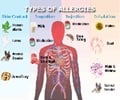According to a new research, the onset of asthma, eczema or atopy in high-risk children were not been prevented by avoiding house dust mite allergens from the time of birth.
According to a new research, avoiding house dust mite allergens from the time of birth was not prevented the onset of asthma, eczema or atopy in high-risk children.
Furthermore, dietary concerns like increasing the consumption of fish rich in omega-3 fatty acids was also found to be ineffective in children with a family history of asthma and wheezing – research finds.was modifying a child's diet to increase the consumption of omega-3 fatty acids, which are found in high concentrations in oily fish.
The researchers recruited over 600 newborn children with a family history of asthma in western and south-western Sydney. Participants were tracked from their birth to the age of five in a bid to explore the role of early exposure to environmental factors in the development of asthma.
Published in the July 2006 edition of the Journal of Allergy and Clinical Immunology the study was designed specifically to test house dust mite (HDM) avoidance and dietary fatty acid modification as interventions to prevent asthma and allergic disease in children with a family history of asthma and wheezing.
Parents testing house dust mite avoidance were instructed to use both physical and chemical methods to reduce their child's exposure to HDM allergens, including changes to bedding materials and the addition of a benzyl benzoate-containing solution to the wash at regular intervals. The HDM avoidance strategy resulted in reduction in HDM allergen concentrations in the child's bed but did not reduce the rate of asthma, wheeze or atopy.
The dietary intervention was intended to increase the proportion of omega-3 fatty acids consumed in a diet and reduce the content of omega-6 fatty acids. Parents were provided with cooking oils and margarine high in omega-3 fatty acids to use in food preparation and food oil capsules were added to the child's formula or to solid foods from the age of 6 months.
Advertisement
The research was undertaken by researchers from the Woolcock Institute of Medical Research, the CRC for Asthma, the Children's Hospital at Westmead and the School of Public Health, University of Sydney.
Advertisement
‘We have shown it's possible to implement feasible strategies to reduce HDM allergen concentrations in a child's bed and create a sustained alteration in the ratio of fatty acids during the first five years of life,’ he said.
‘However as special treatment of children's beds and giving fish oil supplements to very young children with a family history of allergic disease seemed to have little benefit for the prevention of asthma and atopy, at least in the short term, we now need to consider other possibilities’.
It is possible the benefits of the measures taken in early life may not be apparent until after the age of five, so we're really interested to contact these children again in a few years and see how they have developed in regard to asthma,’ he said. Testing of children around the time of their eighth birthday is currently underway.
‘In the meantime, the study results help remove some of the blame parents often take on for not doing enough to prevent their child getting asthma.’
Source: Eurekalert







